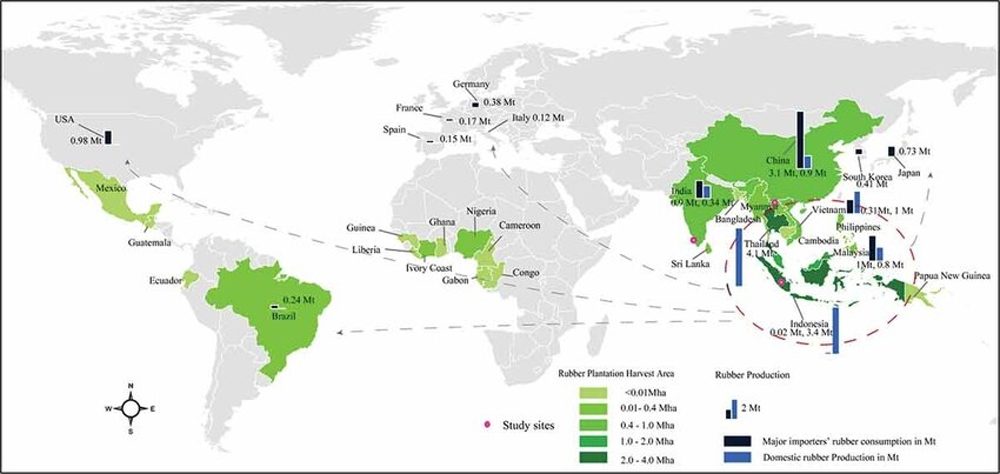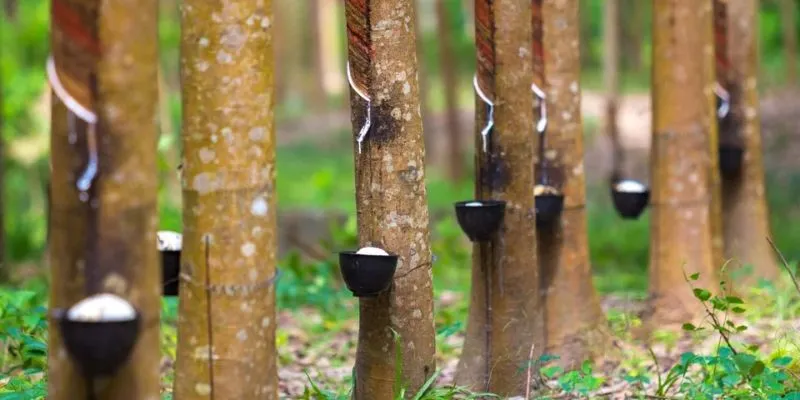Contents
- 1 Current natural rubber latex market size and growth
- 2 Key Drivers of natural rubber latex Market Growth
- 3 Natural rubber latex market Challenges
- 4 Trends of the world rubber market
- 5 Regional Natural rubber latex Market Analysis
- 6 Sustainability and Environmental Considerations
- 7 Conclusion
- 8 ❓ Frequently Asked Questions (FAQ)
The Natural Rubber Latex Market is growing rapidly, driven by rising demand in medical gloves, mattresses, adhesives, and automotive components. Known for its elasticity, durability, and eco-friendly nature, natural rubber latex is essential across industries. In this blog, Ngoc Chau Natural Rubber explores key trends, challenges, and opportunities shaping the global market—helping manufacturers and investors stay ahead.
Current natural rubber latex market size and growth
The global natural rubber latex market is currently experiencing and is projected to continue on a trajectory of significant and robust growth, presenting substantial opportunities for stakeholders across the value chain. The figures underscore the increasing importance and demand for this versatile raw material.
Market Value in 2025: The global market for natural rubber latex is estimated to reach a substantial value of $11.59 billion in the year 2025. This reflects the already strong demand and the integral role that NRL plays in various essential industries.
Projected Value in 2029: Demonstrating a healthy growth trajectory, the market is projected to expand to an impressive value of $14.86 billion by the year 2029. This increase of over $3 billion in just four years highlights the dynamic nature of the market and the increasing reliance on NRL.
Compound Annual Growth Rate (CAGR): Between 2025 and 2029, the natural rubber latex market is expected to grow at a Compound Annual Growth Rate (CAGR) of 6.4%. This significant CAGR indicates a consistent and accelerating demand for NRL, making it an attractive sector for investment and development.
Key Drivers of natural rubber latex Market Growth
The increasing global demand for natural rubber latex (NRL) is propelled by a confluence of critical factors across various industries. Understanding these drivers is essential for stakeholders looking to capitalize on the market’s upward trajectory.
Healthcare Sector: Heightened Hygiene Standards and Medical Advancements. The healthcare industry remains a primary consumer of natural rubber latex, particularly in the manufacturing of medical gloves. Heightened global awareness of hygiene and infection control, amplified by recent health crises, has significantly increased the demand for these protective barriers
Automotive Industry: The automotive industry is another significant driver for NRL demand. Latex’s unique properties, including its elasticity, resilience, and damping characteristics, make it indispensable in various automotive applications. The increasing global production of vehicles, especially in emerging economies, directly translates to a higher demand for NRL.
Eco-Friendly Materials: There is a discernible and growing consumer preference for plant-based and biodegradable alternatives over synthetic materials across a wide range of applications. Natural rubber latex, being a renewable resource derived from the Hevea brasiliensis tree, aligns perfectly with this sustainability trend.
Regulations: Governments and international bodies worldwide are increasingly implementing stringent policies that encourage sustainable production practices.
Natural rubber latex market Challenges
Despite its promising growth trajectory, the natural rubber latex market faces several significant challenges:
- Supply Shortages: The production of natural rubber latex often falls short of consumption demand due to the limited available cultivation areas, the long growth cycle of rubber trees, and climate-related issues such as droughts, floods, or diseases that negatively impact yields.
- Price Fluctuations: The price of natural rubber latex is highly sensitive to global economic instability, supply and demand dynamics, as well as speculative factors in the raw material markets. This volatility creates difficulties for both producers and consumers in long-term planning.
Addressing these challenges and ensuring the sustainable development of the market requires coordinated efforts:
- Investment in sustainable farming practices: Implementing advanced cultivation methods that increase yield per unit area, strategically expanding new planting areas, and protecting the environment.
- Improved supply chain logistics: Optimizing harvesting, processing, transportation, and storage processes to minimize waste, ensure a stable supply, and reduce costs.
Trends of the world rubber market
The natural rubber latex industry is evolving significantly with several innovative trends that promise a more sustainable and responsive future for the market:
- Advanced Processing Technologies: Continuous improvements in centrifugation and purification techniques are significantly enhancing the quality of latex products, resulting in higher purity and superior technical properties.
- Low-Protein Latex Products: The development of non-allergenic options with low or eliminated protein content is a crucial advancement, particularly for sensitive applications like medical gloves, helping to protect users from potential allergic reactions.
- R&D Investments: Increased funding for research is focusing on discovering and developing more sustainable production methods, minimizing environmental impact, as well as exploring new applications for latex across various industries.
- Integration with Technology: The growing use of traceability systems allows for the monitoring of the entire supply chain from plantation to end product, ensuring transparency in sourcing and production processes and meeting the increasing demands for social and environmental responsibility.
These positive trends not only position the natural rubber latex industry for long-term growth but also demonstrate a commitment to meeting the increasingly stringent demands of consumers for safer, more sustainable, and higher-quality products.
Natural rubber latex can be used as a wide range of raw materials for many manufacturing industries. To learn more, you can refer to the article below.
Applications of Natural Rubber Latex 60% DRC in production
Regional Natural rubber latex Market Analysis
Global natural rubber latex production is primarily concentrated in the Asia-Pacific region, which benefits from favorable climate and soil conditions for rubber tree cultivation. The four leading countries in this region are Thailand, Indonesia, Vietnam, and Malaysia, each playing distinct roles in the global supply chain:
- Thailand & Indonesia: These are markets with many years of experience in production, accounting for the majority of global output. They have a mature supply chain, from cultivation and processing to export, with a long history of rubber industry development and large-scale production. Favorable soil conditions make their prices high.
- Vietnam has emerged as a major producer and exporter of natural rubber latex globally, currently ranking second in the world in terms of output. Vietnam boasts not only a significant production volume but also one of the highest rubber tapping productivity rates in Asia. This is due to the adoption of new rubber tree varieties, improved cultivation practices, and efficient farm management. Vietnam is increasingly developing a sustainable rubber industry, as evidenced by the increasing certification of rubber plantations to international and national standards. With favorable natural conditions, experience in cultivation, and investment in sustainable development, Vietnam has significant growth potential in the future and consolidates its position as one of the world’s leading centers for the production and supply of natural rubber latex.
- Malaysia is considered an emerging market with significant growth potential. In recent years, Malaysia has actively invested in sustainable farming practices, adopting advanced techniques to enhance yield and latex quality.
Major consuming markets for natural rubber latex are concentrated in developed industrial regions, particularly North America and Europe. High demand in these areas stems mainly from crucial industries such as the production of medical products
Sustainability and Environmental Considerations
Sustainability is becoming a key focus in the natural rubber industry due to rising environmental concerns:
- Eco-Friendly Production Practices: Companies are increasingly prioritizing the adoption of agroforestry methods during cultivation to maximize land-use efficiency, conserve biodiversity, and minimize negative environmental impacts.
- Traceability Systems: The implementation of traceability systems, such as GPS-enabled tracking of plantations, helps ensure transparency throughout the entire supply chain, from the origin of the trees to the final product, meeting the growing demands for social and environmental responsibility.
These efforts not only align with the increasing consumer preference for biodegradable materials but also contribute to the global goal of reducing carbon footprints, moving towards a more sustainable future for the natural rubber industry.
Conclusion
The Natural Rubber Latex Market is set for strong growth, driven by rising global demand. For manufacturers, traders, and investors, understanding these dynamics is key to long-term success.
👉 At Ngoc Chau Natural Rubber, we deliver consistent quality, certified standards, and reliable supply.
📩 Contact us today for free samples & quotations:
-
📞 WhatsApp: +84 90 284 60 87
❓ Frequently Asked Questions (FAQ)
1. What is Natural Rubber Latex used for?
It’s essential in the Natural Rubber Latex Market, widely applied in medical gloves, mattresses, adhesives, automotive parts, and footwear.
2. What drives the growth of the Natural Rubber Latex Market?
Growth is fueled by rising global glove consumption post-pandemic, demand for eco-friendly materials, and the expansion of automotive and bedding industries.
3. Which industries rely most on Natural Rubber Latex?
Healthcare, bedding, adhesives, automotive, and footwear remain the largest consumers in the global Natural Rubber Latex Market.
4. What challenges does the Natural Rubber Latex Market face?
Challenges include shipping cost volatility, weather-driven price swings in Southeast Asia, and rising competition from synthetic rubber.
5. Why choose Ngoc Chau Natural Rubber as a supplier?
We deliver certified quality, stable supply, flexible packaging, and competitive pricing — trusted worldwide in the Natural Rubber Latex Market.














 Ms Evan
Ms Evan